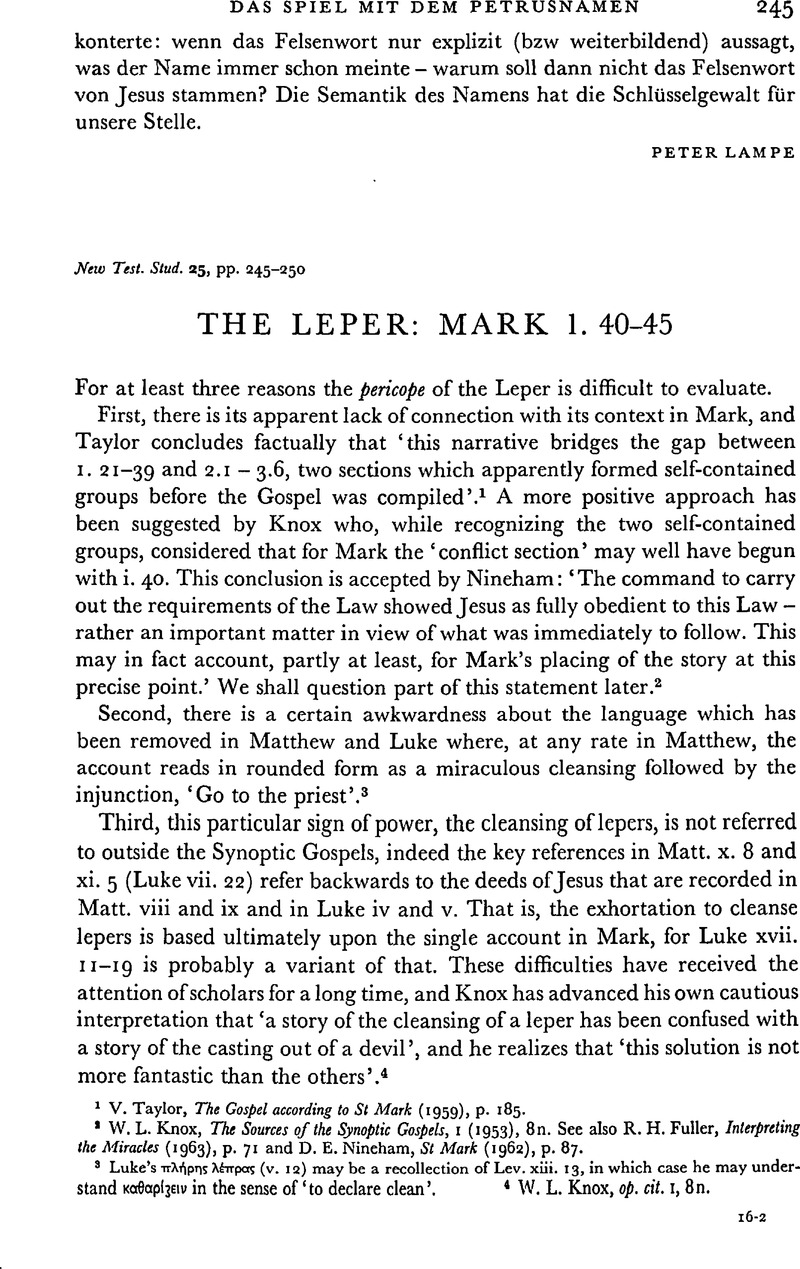Article contents
The Leper: Mark 1. 40–45
Published online by Cambridge University Press: 05 February 2009
Abstract

- Type
- Short Studies
- Information
- Copyright
- Copyright © Cambridge University Press 1979
References
page 245 note 1 Taylor, V., The Gospel according to St Mark (1959), p. 185.Google Scholar
page 245 note 2 Knox, W. L., The Sources of the Synoptic Gospels, 1 (1953), 8nGoogle Scholar. See also Fuller, R. H., Interpreting the Miracles (1963), p. 71Google Scholar and Nineham, D. E., St Mark (1962), p. 87.Google Scholar
page 245 note 3 Luke's πλήρης λήπρας (v. 12) may be a recollection of Lev. xiii. 13, in which case he may understand καθαρίςειν in the sense of ‘to declare clean’.
page 245 note 4 Knox, W. L., op. cit. 1, 8n.Google Scholar
page 246 note 1 Montefiore, C. G., The Synoptic Gospels (1909), p. 71.Google Scholar
page 246 note 2 Taylor, V., op. cit. pp. 185 f.Google Scholar; Cranfield, C. E. B., The Gospel according to St Mark (1963), p. 92.Google Scholar
page 246 note 3 Taylor, V., op. cit. p. 185.Google Scholar
page 246 note 4 Edersheim, A., The Life and Times of Jesus the Messiah, 1 (1883), 492Google Scholar. ‘If anyone had obtained by prayer to God the recovery from that plague… such an one returned thanks to God’ (Jos. Ant. 3. 264). God strikes (![]() ); God alone can heal.
); God alone can heal.
page 246 note 5 Dalman, , The Words of Jesus (1902), p. 65.Google Scholar
page 247 note 1 Lake, K., H.T.R. 16 (1923), 197 ff.Google Scholar; Cadoux, A. T., The Sources of the Second Gospel (1935), p. 44Google Scholar; Rawlinson, A. E. J., The Gospel according to St Mark (1925), pp. 20 ff., 256Google Scholar; Richardson, A., The Miracle Stories of the Gospels (1941), p. 60Google Scholar; Cranfield, , op. cit. p. 92.Google Scholar
page 247 note 2 This would receive some support from Torrey, C. C., The Four Gospels (1947), p. 298Google Scholar, who points out that ![]() can mean ‘rebuke severely’, and also ‘charge strictly’.
can mean ‘rebuke severely’, and also ‘charge strictly’.
page 247 note 3 Bernard, J. H., Commentary on the Gospel according to St John, 2 (1928), 392 f.Google Scholar
page 247 note 4 Swete, H. B., The Gospel according to St Mark (1902), p. 30.Google Scholar
page 248 note 1 M. Neg. 3.1; T. Neg. 3.1.
page 248 note 2 The highest degree of uncleanness, the primary source of ritual impurity, is the dead body (Num. xix. 11–21). It is the ![]() , ‘the father of the fathers of uncleanness’ (for
, ‘the father of the fathers of uncleanness’ (for ![]() in this sense see Daube, D., The New Testament and Rabbinic Judaism (1956), p. 65)Google Scholar. From this descend the
in this sense see Daube, D., The New Testament and Rabbinic Judaism (1956), p. 65)Google Scholar. From this descend the ![]() the ‘fathers of uncleanness’, or secondary sources of impurity (Num. xix. 22), and this impurity is transmitted in diminishing intensity through the ‘child of uncleanness’ (
the ‘fathers of uncleanness’, or secondary sources of impurity (Num. xix. 22), and this impurity is transmitted in diminishing intensity through the ‘child of uncleanness’ (![]() ) to the ‘child of the child of uncleanness’. Leprosy is the first of the ‘fathers of uncleanness’, thus the leper is as one dead.
) to the ‘child of the child of uncleanness’. Leprosy is the first of the ‘fathers of uncleanness’, thus the leper is as one dead.
page 248 note 3 Baumgarten, J. quoted in Jacob Neusner, ‘The Fellowship in the Second Jewish Commonwealth’, H.T.R. 53 (1960), 125–42Google Scholar. See also Jeremias, J., Jerusalem in the Time of Jesus (1969), pp. 246–67.Google Scholar
page 248 note 4 Finkelstein, L., The Pharisees (1946), pp. 52 f.Google Scholar
page 249 note 1 Daube, D., The New Testament and Rabbinic Judaism (1956), pp. 206–23Google Scholar. See also Newman, J.Semikah (1950), pp. 19, 28 ff.Google Scholar, 68. Lk. xii. 14 is an instance where Jesus was called upon to act as ‘lay arbiter’ (![]() ), and there again he refused.
), and there again he refused.
page 249 note 2 S.J.T. 6 (1953), 291–3.Google Scholar
page 249 note 3 Creed, J. M., The Gospel according to St Luke (1942), p. 255.Google Scholar
page 249 note 4 Plummer, A., Commentaty on St James and St Jude (1891), p. 277.Google Scholar
page 249 note 5 I owe this observation to Professor J. R. Porter.
page 250 note 1 Nineham, D. E., St Mark (1963), p. 87.Google Scholar
- 4
- Cited by


